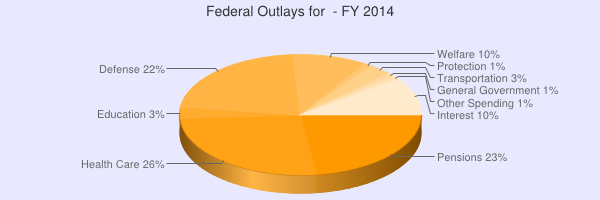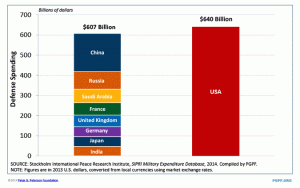WASHINGTON — The United States allocates more for defense spending than the next eight countries combined. This fiscal year’s defense spending represented roughly 20 percent of all federal expenditures. Defense spending has been on the increase over the past few decades. And as national security threats evolve, a tug of war has emerged between Congress, the Pentagon and the President over defense spending.
One national security expert, William D. Hartung, provided some insight into the long-term budgetary realities facing the Department of Defense at a recent lunch event.
According to Hartung, America’s increasing fiscal challenges often call into question what kind of defense spending should be prioritized, creating a divide between Republicans and Democrats about how to remedy the issue while keeping America protected and prepared. Some opponents of the changes contained in the $640 billion defense budget claim the approved cuts will affect the nation’s readiness against threats.
But Hartung, former director of the Arms and Security Initiative at the New America Foundation, said there are only so many places where budget cuts can occur. Hartung now serves as the director for the Common Defense Campaign: Arms and Security Project at the Center for International Policy.
Military and civilian personnel within the Department of Defense constitute nearly half of the Pentagon budget, Hartung said.
In March, President Barack Obama released his 2015 defense budget that would take effect in October, calling for $495.6 billion for the military. That’s $4 billion less than the previous year and still below the spending cap set by Congress under the Bipartisan Budget Act. Obama’s budget cuts the size of the military’s ranks and cuts funding from most major weapons-buying accounts.
Initially Defense Secretary Chuck Hagel called the president’s budget “responsible, balanced and realistic.” Later Hagel spoke up at a House of Representatives Armed Forces Committee hearing saying he was concerned about sequestration, or automatic budget cuts, that could “compromise our national security” if fully implemented in 2016.
Hagel said, “The result would be a military that could not fulfill its defense strategy, putting at risk America’s traditional role as a guarantor of global security and ultimately our own security.”
The fiscal 2015 budget reduces the Army to 450,000 soldiers. The Marines will drop to 182,000. The budget allows for a 1 percent pay increase for FY15, but freezes pay for general and flag officers.
Another area where Hartung said cuts can be made is to investment accounts.
Recent discussion within the administration includes cutting some aircraft, like the A-10 close air support attack aircraft. The FY15 defense budget also includes plans to build a new bomber, refueling tanker and the F-35, a single-seat fighter plane. The Navy will maintain 11 carrier strike groups, but combat ships will be put on hold, Hartung said. Other aircraft like the Kiowa Warrior helicopter, used in Iraq, could be replaced by Apache helicopters and drones.
In May, a House appropriations subcommittee approved a defense spending measure that would let the Air Force retire the A-10. The plan would retire all 283 in the fleet, saving $4.2 billion over five years.
Another area that Hartung suggested may benefit from defense budget cuts is within operations and maintenance.
Hartung also cited areas that are not subject to the Bipartisan Budget Act, which set overall discretionary spending for the current fiscal year. Areas such as the Overseas Contingency Operations Account, also known as the war budget, are not subject to the caps, he said.
Citing research done by the Center for Strategic and Budgetary Assessments, Hartung shared their findings that at least at least $20 billion in the 2014 war budget that was not related to the War in Afghanistan or other overseas conflict.
With each branch – the Pentagon, White House, and Congress – each having their own agenda and vision for the future of the military, it has become difficult to create a defense spending budget that is agreed upon, meets the future needs of the military, prepares for impending danger, and lessens the overall debt of the nation.


